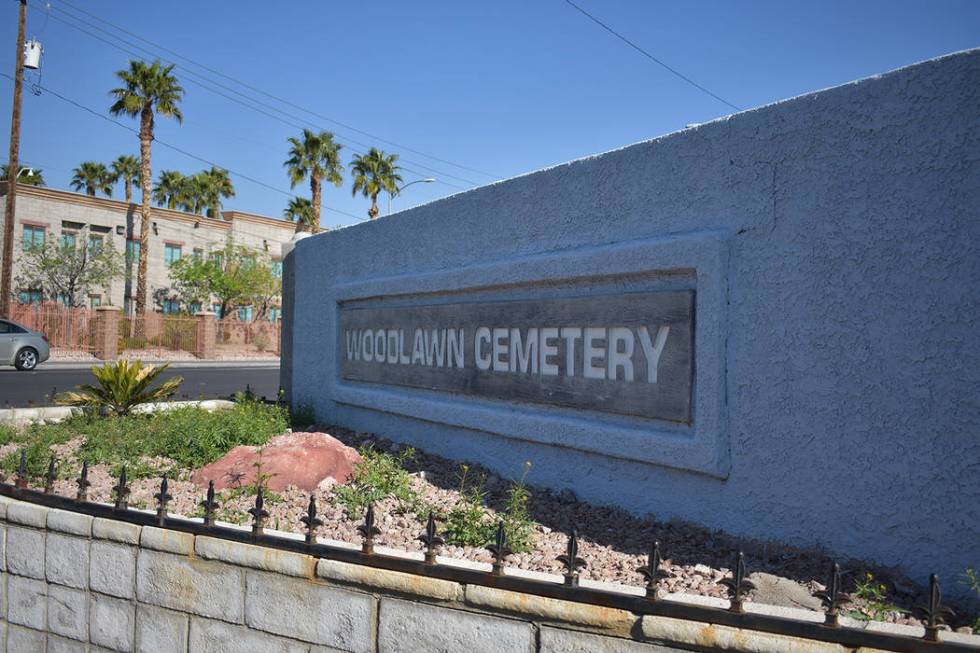‘Story of Las Vegas’ traced at Woodlawn Cemetery

Politicians, gamblers, lawyers, judges and two Civil War veterans — one Union, one Confederate — share the large, flat, grassy space in one of Clark County’s oldest cemeteries.
Woodlawn Cemetery was built in 1914 on 10 acres of donated land, according to a plaque at the front of the cemetery. The cemetery is home to the Veterans Memorial Circle, a circle surrounded by road with a plaque and flagpole in the center. The memorial circle was established on Armistice Day — now known as Veterans Day — in 1939, according to the American Legion’s website.
Betty Wiley, assistant administrator of Woodlawn Cemetery, said there are four sections of the cemetery solely dedicated to veterans. She couldn’t say how many veterans have been buried at the cemetery.
“The story of Woodlawn is the story of Las Vegas,” said Rosalie Lidard, volunteer with the Nevada Preservation Foundation. She and another volunteer with the foundation, Mitch Cohen, presented a talk titled “The Story of Woodlawn” at a Friends of the Nevada State Museum meeting March 21 at the museum.
Lidard said Woodlawn was “built under a park memorial concept, around the idea that graves should be flat to emphasize park spaces so the living can enjoy them.” It’s now operated by Bunkers, a Las Vegas-area mortuary, cemetery and crematory company.
The Preservation Foundation provides tours of Woodlawn in October, sharing the history of people buried there. The nonprofit organization is dedicated to preserving and revitalizing historic buildings and places.
Wiley said the cemetery had a service Tuesday, putting the number of estimated burials there at 29,617. It is at 1500 Las Vegas Blvd. North.
Among the individuals buried at Woodlawn is famed high-stakes gambler Nick Dandolos, known as “Nick the Greek.”
According to Cohen, Dandolos is known in part for his five-month ongoing poker match against another professional gambler, Johnny Moss. The marathon session in front of a live audience inspired the World Series of Poker.
Dandolos died in 1966 and was one of seven men inducted into the Poker Hall of Fame in 1979. Moss also was part of that inaugural class.
Cohen said the two Civil War veterans, William Keith and Joseph Graham, are buried next to each other. They met in the Las Vegas area after the war and “thought it would be neat to be buried together,” Wiley said.
Graham, the Confederate veteran, died first, in 1917. Keith ensured he was buried next to him when he died in 1920.
Lidard said Woodlawn was the major cemetery in Las Vegas before 1970. That changed as other cities were established in the growing city, Cohen said.
The cemetery takes up a block of Owens Avenue between Las Vegas Boulevard North and Bruce Street. On a Monday morning, Las Vegas Boulevard was buzzing, with people going in and out of Catholic Charities across the street and cars speeding by. Woodlawn was quiet; the only people present were a few men working on the lawn.
The cemetery has been on the National Register of Historic Places since 2006. It is included on the city’s Pioneer Trail, a 6-mile tour of the city’s historical sites.
Woodlawn has grown to about 40 acres. Cohen and Lidard say Woodlawn will be visited for years after the acres are filled.
Wiley said people purchase property at the cemetery for future use, and sometimes it never gets used. With that said, she estimated the cemetery will be sold out within three years.
Contact Rachel Spacek at 702-387-2921 or rspacek@reviewjournal.com. Follow @RachelSpacek on Twitter.